■
BATTLE-INTERFACE TIPS
PAUSE GAME
|
Campaign Hints and Tips |
|
Some trusty pointers
for making sure that you utterly dominate the
single-player campaign.
AUTO-MANAGEMENT:
One of the most useful features in the campaign game is
the auto-management tab. By clicking on the arrow to the
righthand side of the mini-map, youÆll bring up a number
of options for allowing the AI to control parts of your
empire ù e.g., taxation, assignment of titles,
construction of buildings, and so on. This feature
allows you to customize the game to suit your particular
preferences.
SHIFT:
Hold down Shift to see the
happiness ratings of the population in each of your
regions. Regularly doing this will help you keep a check
on the stability of your empire ù and help prevent
unexpected and unwelcome revolts throughout your
provinces.
INQUISITORS:
Use inquisitors to sit in regions that are vulnerable to
revolt. If the region is feeling unhappy, the
inquisitors will often deal with the problem by
massacring the unruly mob and preventing the revolt!
CRUSADES:
You can use crusades tactically in a number of ways.
Early in the campaign, while youÆre still building up
your armies, build as many crusades as you can and send
them to the nearest destinations available. This way,
once the destination region has been conquered, youÆll
have a new army of advanced units at your disposal. This
tactic can also be used to extend the borders of your
empire (provided youÆre able to send crusades to these
regions).
Another ploy is to choose destinations that require you
to move through regions that are controlled by your
allies. This way, youÆll gather your alliesÆ troops into
your crusade and weaken their armies. (Hell, youÆll want
to kick their butts sooner or later ù may as well make
the job easier!) |
At any point in a
battle, press P to pause the action. The action will stop but
the camera will still be operable, and you can still give
orders and waypoints to all units. Pressing the Spacebar at
this time will show you where your new unit destinations are.
Press P again to resume the action. In this way, you can play
the 3D battles as a kind of pseudoûturn-based experience. ItÆs
also a handy way to recompose yourself when the action gets
really hectic!
DRAG SELECTION BOX
Hold Ctrl and
right-click and drag to create a box around several units at
once. This method of selecting units will be familiar to
mainstream RTS gamers, and is a handy way of selecting several
units in close proximity to each other in the heat of battle.
WAYPOINTS
Waypoints are an
extremely useful way of pulling off devastating flanking
maneuvers. Simply hold down Shift and then left-click to form
a path of flags on the battlefield for your unit to follow.
This technique can also be used when multiple units are
selected.
■
BATTLEFIELD
TACTICS
The most important
thing to remember when fighting battles is that, unlike in
most other strategy games, MedievalÆs battles are a
realistic simulation of the way combat was at that time. All
the factors that used to affect real troops and real armies
are here. So if you charge your heavily armored units from one
end of the battlefield to the other, theyÆll get tired and
wonÆt fight as effectively. If a unit is taking severe fire
from enemy archers or gets charged in the flank by heavy
cavalry, the morale of the men will suffer ù and they could
end up running for their lives.
This authenticity
actually makes the game much more intuitive than other
strategy games because it means you donÆt have to learn the
tactics that fit best with that particular game ù you just
need to apply common sense. A few good tips for beginners:
ROCK/PAPER/SCISSORS
As a general rule,
MedievalÆs units adhere to the well-known
rock/paper/scissors mechanism. In a nutshell, there are three
primary types of units: archers, spearmen, and cavalry ù and
each of them is a perfect foil for another.
Archers will defeat
spearmen because their light armor enables them to move
faster, allowing them to fire their arrows, then retreat and
fire again ù with the slow-moving spearmen never being able to
reach them to engage them in hand-to-hand combat.
With their long
spears, spearmen are more effective against cavalry. A cavalry
charge will often come to an abrupt (and bloody) end when
confronted by a wall of spears!
At the same time,
cavalry units are particularly effective at chasing down and
massacring the lightly armored archers, who can usually
unleash only a few rounds of arrows prior to being engaged.
ItÆs a simple enough
concept, but players who keep it in mind will find they spend
more time tasting sweet victory than players who donÆt. YouÆll
notice that we donÆt mention infantry here. Infantry fall
outside of this set of rules, and are generally pretty
effective against all kinds of units.
|
Kingdom Management 101 |
|
Our resident
Medieval buff, Billy
Harms, couldnÆt resist giving a few tips of his own.
MAKINÆ
MONEY: At the
start of a game, look over your territories and see
which ones have exportable goods and/or exploitable
natural resources. If you have resources, immediately
build structures thatÆll let you access their riches
(like gold mines), and if you have tradeable goods, get
started on trading posts, merchants, and docks. If a
territory doesnÆt offer any riches you can tap into,
simply upgrade your farming capacity and move on to
creating military units.
RELIGIOUS
DIFFERENCES: When
conquering new territories, remember that religion plays
a huge role in
Medieval.
For example, if youÆre playing as a Muslim nation and
you conquer a Christian territory, youÆll need to
evangelize your religion to the masses, lest they decide
they donÆt like rule under a non-believer.
UP FROM
THE ASHES:
When you obliterate a
foreign power, make sure that you keep a sizable
military force in their former territories, especially
in what used to be their capital territory. After a
period of time passes, a leader may arise in that area
and rally the people to their true lineage. These kinds
of ôrebellionsö can be extremely devastating, especially
if youÆre not prepared. Remember, the only thing rebels
understand is the taste of cold, hard steel. |
POSITIONING (TAKE THE HIGH GROUND!)
The positioning of
your troops is vital. Even if you are greatly outnumbered,
finding and holding a good position on the battlefield will
increase your chances of victory immeasurably. When deploying
troops, look to position them on the highest piece of ground
within your deployment zone. Armies attacking uphill suffer
massive penalties, as theyÆll have less momentum and will be
tired from the climb. Your archery units will also have a
better range and accuracy when firing from higher ground and
your units will receive a bonus when attacking downhill. In
other words, every possible advantage is with the army on
higher ground. Armies that maintain a strong position on high
ground and maintain their discipline can defeat much stronger
armies.
CHOOSE A WELL-BALANCED ARMY
The basic
rock/paper/scissors mechanism mentioned earlier means that a
well-balanced army is strongly recommended. No matter how
powerful and indestructible you may feel your veteran
heavy-cavalry units are, theyÆll soon come a cropper if met by
a well-balanced enemy army. Also bear in mind that an army is
likely to come across all manner of different terrain, enemy,
weather conditions, and so on, so try to maintain armies that
are balanced enough to cope with most conditions.
A well-balanced army
can have many different combinations of units. HereÆs an
example for the English: four knights, three longbowmen/archers,
six infantry, and three billmen. This combination provides
good protection against enemy cavalry (with three units of
billmen), a solid core (with six infantry), speed, a
devastating charge, and the ability to chase routing units off
the field (with the cavalry), as well as the ability to pepper
enemy units from a safe distance (with the longbowmen).
CHASE ROUTERS OFF THE FIELD WITH CAVALRY
If, at any time
during a battle, the enemy starts to rout, send cavalry units
to attack the routing units. This maneuver will make it very
hard for the routing units to rally and rejoin the battle ù
and youÆll also inflict more casualties and take more
prisoners (which can be sold for profit or massacred to gain
ôdreadö). Continue chasing these units until they leave the
battlefield. Routing units inflict a morale penalty on the
whole army, so youÆll often be able to cause a mass rout in
this way.
Be wary of charging
off a hilltop to chase routing units, however. The enemy will
sometimes use this temptation as a ploy to draw you away from
your advantageous position on top of a hill. Remember the
folly of Harold at the Battle of Hastings!
■
MORE
BATTLEFIELD TACTICS ù FORMING FORMATIONS
The formation that
your army lines up in is crucial. YouÆll often find your own
preferred formations, but here are a few examples that our
in-house testers have used in both single- and multiplayer
games to great effect. (DF = defensive formation, OF =
offensive formation)
STANDARD LINE (DF)
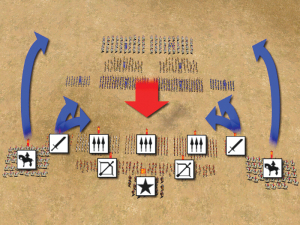
As the name
suggests, this is a pretty standard defensive formation. The
spearmen in the front-center provide good defense against a
full-frontal assault (especially from cavalry), and also
protect the archers while they loose arrows into the
approaching army. Your flanks are protected by cavalry, which
can (if the opportunity arises) charge into your opponentÆs
flanks from this position. The infantry on the fringes of your
front line can be used to bolster the line or charge into the
flanks of attacking units once theyÆve engaged your spearmen.
CIRCULAR (DF)

This formation
provides a good defense from an
attack on more than one front. Such an attack may come from
two or more enemy armies ù or from a single opponent thatÆs
divided its forces and is attempting to flank you. The
spearmen at the front and sides form a formidable defensive
line, and the central infantry units can be used to bolster
any breaches. The archers that are protected by the spearmen
have a wide angle of fire ù and can even be used in melee to
help bolster the line if necessary. In this formation, the
cavalry are free to be used to flank the enemy, or to remain
in reserve and run down routing enemy units. The general is in
the center, giving a maximum morale boost to his entire army
while remaining heavily protected.
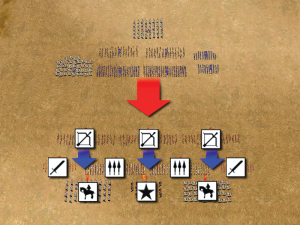 ARCHER
SKIRMISH (DF) ARCHER
SKIRMISH (DF)
This formation gives
your archers maximum opportunity to inflict heavy casualties
on the enemy army while it marches toward you. Make sure that
your archers have the ôskirmishö icon selected so that they
retreat of their own accord when the enemy gets close. ItÆs
also a good idea to set them to ôlooseö formation so that they
can retreat through the defensive line more easily when the
enemy closes in.
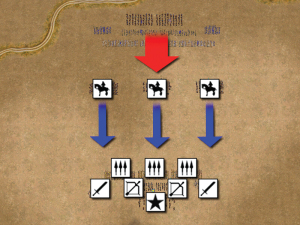 CAVALRY
SKIRMISH (DF) CAVALRY
SKIRMISH (DF)
This formation is
similar to the archer skirmish but with horse archers. The
benefit of using horse archers is that, with their much
greater speed, they can afford to engage the enemy with arrow
fire while a good distance from the rest of your army. This
scenario not only maximizes the amount of arrow fire the enemy
must suffer prior to reaching your main army, but also tends
to draw the enemy cavalry out to attack them. If you then
retreat the horse archers back to your main army (with the
impetuous enemy cavalry chasing them), you can sometimes
entrap the enemy cavalry by charging your own cavalry into the
gap between the distant enemy army and their cavalry, thereby
snaring them between your front line. Of course, if the enemy
cavalry arenÆt drawn out to attack, then your horse archers
will be able to fire their entire constituent of arrows with
nothing but enemy archers to concern them.
CAVALRY CHARGE (OF)
A very aggressive
formation that should be used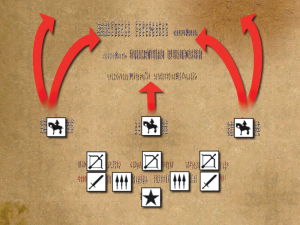 only if your enemy forms up with archers in the front line.
ItÆs designed to engage the defending enemy army quickly in
order to avoid a prolonged archery assault. With your
strongest cavalry units charging at the center of the enemy
front line and the rest of your cavalry running flanking
formations against the enemy position, the enemy archers will
sometimes skirmish backward and cause minor disruption to the
enemy line. Always make sure that your infantry is also in
close support to make the most of this situation ù and also to
prevent your cavalry from becoming overwhelmed by superior
enemy numbers.
only if your enemy forms up with archers in the front line.
ItÆs designed to engage the defending enemy army quickly in
order to avoid a prolonged archery assault. With your
strongest cavalry units charging at the center of the enemy
front line and the rest of your cavalry running flanking
formations against the enemy position, the enemy archers will
sometimes skirmish backward and cause minor disruption to the
enemy line. Always make sure that your infantry is also in
close support to make the most of this situation ù and also to
prevent your cavalry from becoming overwhelmed by superior
enemy numbers.
 CAVALRY
SWEEP (OF) CAVALRY
SWEEP (OF)
When the enemy
places its archers at the front of its battle lines, counter
this setup with your cavalry. Send them up the flanks and then
turn them in so that they charge across the enemy lines and
attack the archers. As they do so, theyÆll draw out the
stronger enemy units, exposing them to your arrow fire. Keep
your cavalry away from any spearmen and return them to the
flanks to try again.
FEIGN RETREAT (OF)
As with most other
offensive strategies, the theory here is to draw the enemy
army (or at least some of its key units) off a hill and onto a
more even-sided fighting ground. Place your infantry and
peasant units at the bottom of the hill away from the main
body of your army. Charge them up the hill as if to attack the
enemy frontline and then, just prior to engaging them, pull
away and run back
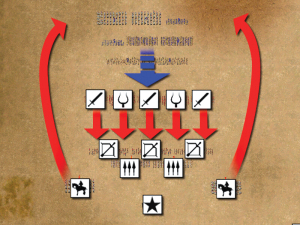 down
the hill. YouÆll undoubtedly be taking heavy arrow fire by
now, so try to make sure that the enemy takes the bait the
first time around. If the enemy is reluctant to follow,
clicking the ôroutö icon for these infantry and peasants will
make the enemy more likely to leave their positions to ômop
upö your routing units. Your archers can fire volleys into the
enemy as they charge down the hill, while your spearmen
prepare to engage them. Your cavalry is in a position to be
able to run flanking maneuvers against the now-weakened enemy
army on top of the hill ù or to bolster the defense at the
foot of the hill. down
the hill. YouÆll undoubtedly be taking heavy arrow fire by
now, so try to make sure that the enemy takes the bait the
first time around. If the enemy is reluctant to follow,
clicking the ôroutö icon for these infantry and peasants will
make the enemy more likely to leave their positions to ômop
upö your routing units. Your archers can fire volleys into the
enemy as they charge down the hill, while your spearmen
prepare to engage them. Your cavalry is in a position to be
able to run flanking maneuvers against the now-weakened enemy
army on top of the hill ù or to bolster the defense at the
foot of the hill.
SPLIT ADVANCE (OF)
This strategy is
slightly harder to execute than many of the others. The idea
is to use your general unit as bait to suck the enemy army
into a vice-like trap. Split your army into two evenly
balanced forces, and leave your general unit on his own in the
middle. An unprotected general is a very tempting prospect for
an enemy army. Concealing units in any nearby forests will
also be a massive help in the deception. By gradually
advancing your general toward the center of the enemy army, it
should be relatively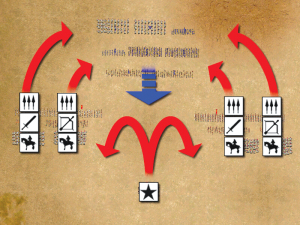 easy to draw some of the enemy units off a hill. Meanwhile,
your two flanking forces
should be advancing slowly along the flanks
(keeping as wide a berth as possible),
ready to spring the trap. Try to drag as much of the enemy
army off the hill as possible before using your large number
of flanking units to attack the enemy army from both sides.
Your general unit is on horseback and should have little
trouble rejoining the battle at a suitable point as soon as
his deception job is completed.
easy to draw some of the enemy units off a hill. Meanwhile,
your two flanking forces
should be advancing slowly along the flanks
(keeping as wide a berth as possible),
ready to spring the trap. Try to drag as much of the enemy
army off the hill as possible before using your large number
of flanking units to attack the enemy army from both sides.
Your general unit is on horseback and should have little
trouble rejoining the battle at a suitable point as soon as
his deception job is completed.
For more Medieval
hints, tips, and strategies, visit the Total War forums at
www.totalwar.com. |




